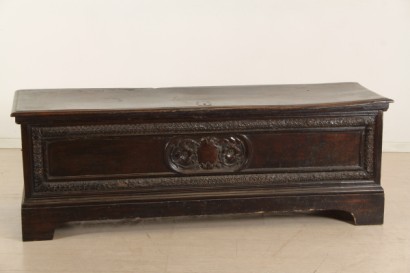Chest
Features
Style: Renaissance (1460-1630)
Age: 17th Century / 1601 - 1700
Origin: Emilia Romagna, Italy
Main essence: Walnut
Material: Solid Walnut
Description
On the front in solid walnut carved a braided belt frame encloses a blazon with floral motifs, shelf, feet in hips wrought iron handles. Replacements and restorations.
Product Condition:
Requires restoration and resumption of polishing.
Dimensions (cm):
Height: 59
Width: 170
Depth: 53
Additional Information
Style: Renaissance (1460-1630)
During the Renaissance, furniture took on architectural forms, perfect proportions, and was adorned with rationally arranged decorations, taken from Greco-Roman iconography.Supports and feet carved in the shape of an acanthus leaf or a lion's paw appeared at least from the early 1460s.
Alongside parallelepiped chests, others appeared in the shape of a classical sarcophagus, with surfaces marked by ornamental metrics rigidly disciplined within pilasters and frames.
The novelty of the sculptural carving decoration derived from archaeological remains triumphs, decoded and reworked stylistic elements in different compositional harmonies arranged in alternating games of dentils, ovules, volutes, acanthus-shaped spirals, loricature, strigliature, grotesque candelabras, and the entire pantheon of pagan mythology comes to life again, in particular to decorate chests, which from their initial function as containers for the wedding dowry take over the new instance of real parade furniture.
It is worth remembering that the displayed furniture was generally richly embellished with gold leaf gilding.
In the first decades of the sixteenth century the use of Certosina inlay definitively faded away, although even in the Renaissance this technique had great fame, just think of the activity of the Tasso workshop in Florence.
Learn more about the Renaissance style with our insights:
The Renaissance style
A pair of candle holders between the Renaissance and Baroque
FineArt: The Renaissance
FineArt: Renaissance Cassina gilded, Belloni family – Venice, 16th century
The dictionary of antiques - Savonarola
INSERT ADDITIONAL LINKS
The Austrian taste of Baroque
The history of furniture in the Renaissance
























